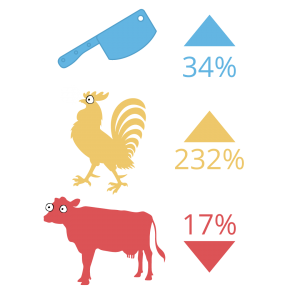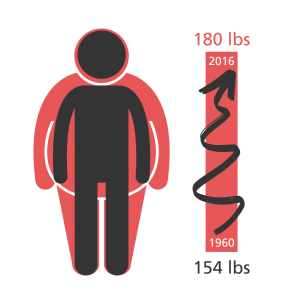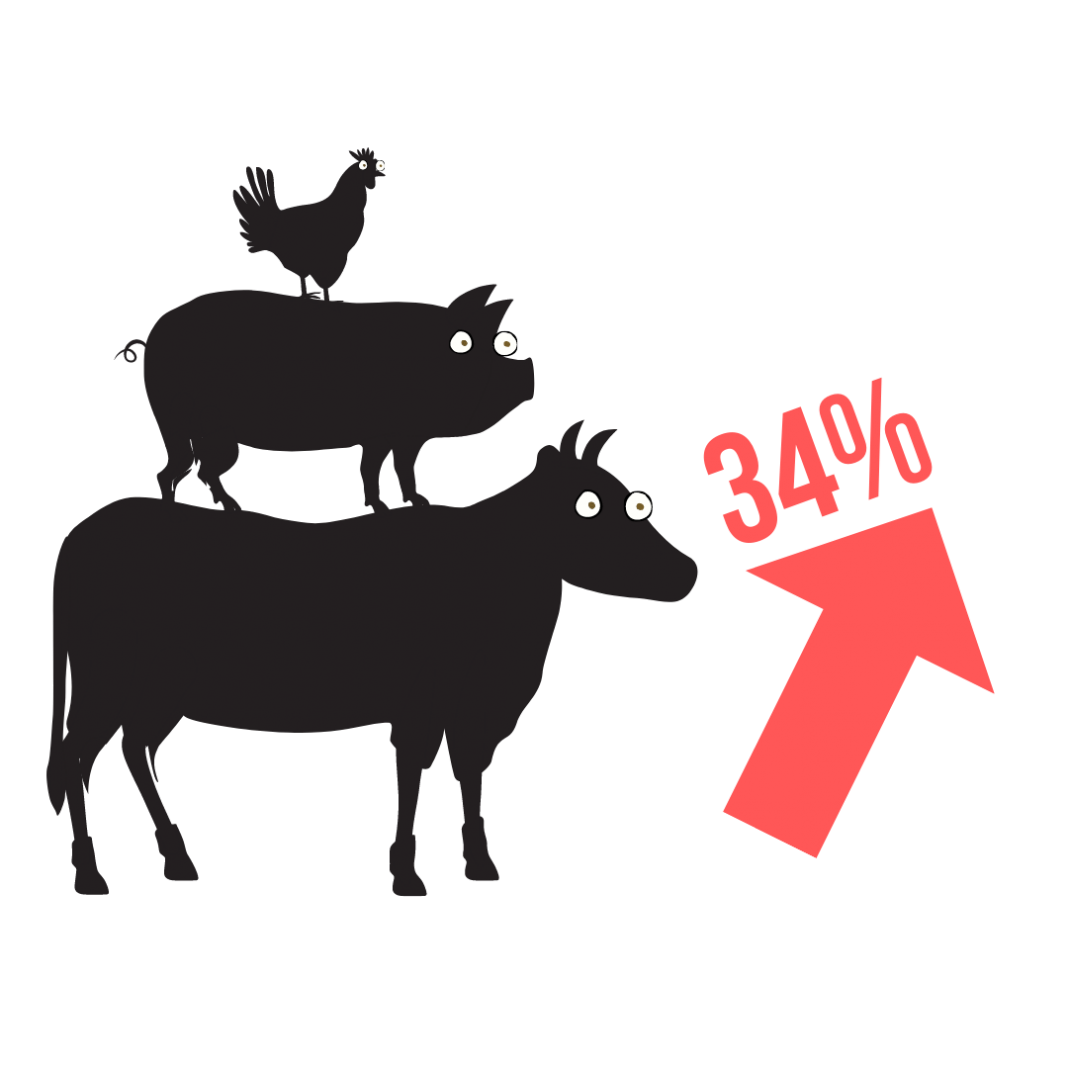The processed meat industry in North America is a $230-billion-dollar venture that produces more than 40% of the world’s beef, pork and poultry supply.
Robust growth is forecast for the industry as global demand and population increase steadily. In the United States, one of the world’s top meat-consuming countries, an estimated 96% of residents include a meat product as part of their daily diet.[1]
Some Netflix documentaries would have you believe that the meat sector is a blatant example of environmental terrorism and that we are all doomed, while Keto-culture[2] trumpets the belief that meat is not just the best path to optimal health, it is the only way. Today, BIG Media takes you on a dive into statistics that may help define your viewpoint.
Economic impact
The U.S., Canada, and Mexico are all big producers and consumers of meat.[3] North America is the fifth-highest producer of meat products (comprising 5% of the collective GDP)[4] and #1 consumer – by almost 25 kilograms more per person, per year, than the next largest consumer.[5] Over the last six decades, Americans have increased their annual meat consumption by 34%, from 75.8 kilograms (167 pounds) of meat consumed per year to 101.6 kg (224 pounds).[6]
The meat industry in North America is credited with creating nearly 7 million jobs (direct and indirect).[7] [8] [9] The job profile is moderate; the average wage for a worker in the meat product manufacturing industry in 2018 in Canada was $21.67 per hour.[10] Further, 99.7% of meat industry companies were classified as “small or medium” (less than 100 employees) and 75% were profitable.[11]
Government spending
The Government of Canada earmarked nearly $2 billion in government subsidies for animal agri-business in 2019 (provincial governments added more to the total),[12] the U.S. Government subsidized its meat and dairy industry to the tune of 38 billion USD in 2016,[13] and Mexico 5 million pesos in 2019.[14]
Environmental Impact
Approximately two-thirds of the world’s agricultural space and one-third of its entire land mass is dedicated to animal agriculture.[15] Like most industrial practices, the environmental impact is negative. However, it could be argued that environmental impact is a necessary result of societal growth. Even staple crops such as rice, wheat, corn, and lettuce all have significant negative environmental impacts. It becomes a question of yield. We first examine output (“emissions”) and then input in relation to human consumption (“yield”).
Agricultural and manufacturing emissions
Carbon dioxide, nitrous oxide, methane, and ammonia are the most common emissions associated with livestock agriculture,[16] which is estimated to contribute about 18% of global greenhouse gases to the atmosphere; manufacturing meat products adds another 13%.[17]
Waste
In the U.S., residential consumption of water accounts for about 5% of the entire system while animal agriculture accounts for around 55%.[18] On the waste-production side, Haines and Staley estimated that a farm with 2,500 milking cows produces the same amount of waste as a city with 411,000 residents.[19]
Yield
The nutritional yield to the consumer is known as “conversion efficiency”, which is how much feed needs to enter the animal’s system before slaughter, compared to the amount of edible meat it produces and the energy (calories) it offers the consumer. Dairy and eggs have a conversion efficiency of 17%, poultry 13%, pork 9%, and beef 3%. There is no equivalent conversion efficiency rating for grains and vegetables because their input needs are different, so researchers generally look at two things: caloric yield per gram and water required to produce the food.
1) 1 gram (g) of protein and 1 gram of carbohydrate each produce about 4 kilocalories (kcal) of energy, while 1 g of fat produces 9 (kcals)
- 1 kg of 70/30 lean beef has about 5,500 calories
- 1 kg of wheat oats has about 3,700 calories
2) 1 kg of beef requires an estimated 3,682 litres of water to raise it to slaughter age[20] while 1 kg of wheat requires 3,654 litres of water to produce 1 kg of wheat[21]
*Beef is by far the least water friendly livestock to raise and wheat is the worst of the cereal grains
When you break down the amount of water it takes to create a kilocalorie of energy, beef uses 0.669 millilitres (mL) per kcal of energy it produces and wheat uses 0.987 mL per kcal it produces.
Health impact
We are not here to debate whether the consumption of meat products is healthy or not, but rather how much consumption might create a health problem. We have shown that about 96% of Americans consume meat products regularly[22] and that Americans eat an average of 26 kg (57 pounds) more meat per year than they did 60 years ago,[23] but what does this mean in the context of health? How much is too much?
A key issue with many of the studies surrounding meat consumption and health is that most of these rely on surveys or self-reporting. While most peer-reviewed studies try to adjust for surveyor bias, etc., it should be acknowledged that these usually have larger probabilities of error. Regardless, a large sample size is often sufficient to highlight trends and suggest correlation.
The current international recommended dietary allowance (RDA) for protein is 0.8 g per kg (0.363 g/lb) of body weight (bw), regardless of age.[24] [25] It is noteworthy that this number is derived from the minimum amount needed to maintain nitrogen balance within the body’s tissues and does not take into account physical activity levels. Those individuals with greater daily physical demands (eg. professional athletes, weightlifters, long-distance runners) require more protein consumption to replenish losses and repair damaged tissues.
Of course, “meat” for human consumption, for the most part, is not 100% protein. Rather, it is a blend of proteins and fats. While consumption of poultry is the fastest-growing trend in meat consumption, beef consumption still represents about 60% of the market share.[26] For the sake of discussion, we will use a typical 70/30 ground beef split (70% protein, 30% fat), also known as “lean ground beef”, which is often used to make burgers, meatloaf, chilli, and other popular North American dishes.

Measured in “adults per tonne (t)” the U.S. adult is 12.25/t – highest in the world at an average of 81.6 kg (180 lbs) per adult.[27] Keeping in mind that the average American weighed 69.9 kg (154 lbs) in 1960,[28] and that consuming an added 25.9 kg (57 lbs) of meat per year over the last 60 years has increased the body’s protein needs based on body weight, the RDA for an average American adult is 65.3 grams of protein. With Americans consuming an average of 101.6 kg (224 lbs) of meat per year, at a 70/30 split translates to roughly 90-100 grams of protein consumed per day.[29]

Studies suggest a negative impact on health when protein is consumed at around two or more times the RDA. Negative effects cited include disorders of bone and calcium homeostasis, disorders of renal function, increased cancer risk, disorders of liver function, and precipitated progression of coronary artery disease.[30] That said, elevated protein intake is correlated with a higher quality of life for adults age 65 and over.[31]
While two-thirds of meat consumers report reducing, or trying to reduce, their consumption,[32] world consumption is trending upward. All human activity affects the environment; in many cases the impact is unavoidable. A good portion of the world’s economic system is based on food distribution, and the meat sector contributes hundreds of billions of dollars per year in economic value to that system. Is it too late to change our ways? Do we even need to change our ways? We leave the opinions to you. Hopefully, the data we provided gives you deeper context as your viewpoints evolve.
[1] https://www.ncbi.nlm.nih.gov/pmc/articles/PMC6088533/
[2] https://www.ncbi.nlm.nih.gov/books/NBK499830/
[3] https://ourworldindata.org/meat-production
[4] https://ourworldindata.org/meat-production
[5] https://www.statista.com/statistics/1037429/per-capita-consumption-of-meat-worldwide-by-region/
[6] https://www.nationalchickencouncil.org/about-the-industry/statistics/per-capita-consumption-of-poultry-and-livestock-1965-to-estimated-2012-in-pounds/
[7] https://www.godan.info/organizations/sagarpa-ministry-agriculture-livestock-rural-development-fisheries-and-food-mexico
[8] https://www.ers.usda.gov/data-products/ag-and-food-statistics-charting-the-essentials/ag-and-food-sectors-and-the-economy/
[9] https://www150.statcan.gc.ca/t1/tbl1/en/tv.action?pid=3610048901&pickMembers%5B0%5D=1.1&pickMembers%5B1%5D=2.1&cubeTimeFrame.startYear=2019&cubeTimeFrame.endYear=2019&referencePeriods=20190101%2C20190101
[10] https://www.ic.gc.ca/app/scr/app/cis/salaries-salaires/3116;jsessionid=0001SLQLMFqdyeGSIt8sWTa55KY:-C7AEJO
[11] https://www.ic.gc.ca/app/scr/app/cis/summary-sommaire/44521
[12] https://innovation.ised-isde.canada.ca/s/group-groupe?language=en_CA&token=a0B5W000000MrTZUA0
[13] https://jia.sipa.columbia.edu/removing-meat-subsidy-our-cognitive-dissonance-around-animal-agriculture
[14]https://apps.fas.usda.gov/newgainapi/api/report/downloadreportbyfilename?filename=Mexico%20Announces%20New%20Agricultural%20Support%20Programs_Mexico_Mexico_4-5-2019.pdf
[15]https://www.academia.edu/17132621/Intensive_Livestock_Farming_Global_Trends_Increased_Environmental_Concerns_and_Ethical_Solutions
[16] https://www.wri.org/blog/2014/05/everything-you-need-know-about-agricultural-emissions
[17] http://www.europarl.europa.eu/climatechange/doc/FAO%20report%20executive%20summary.pdf.
[18] https://www.cell.com/current-biology/fulltext/S0960-9822(07)02346-9?_returnURL=https%3A%2F%2Flinkinghub.elsevier.com%2Fretrieve%2Fpii%2FS0960982207023469%3Fshowall%3Dtrue
[19] https://academic.oup.com/ajcn/article/78/3/660S/4690010
[20]https://www.researchgate.net/publication/14721598_Estimation_of_the_water_requirement_for_beef_production_in_the_United_States
[21] https://www.waterfootprint.org/media/downloads/Report47-WaterFootprintCrops-Vol1.pdf
[22] https://www.ncbi.nlm.nih.gov/pmc/articles/PMC6088533/
[23] https://www.nationalchickencouncil.org/about-the-industry/statistics/per-capita-consumption-of-poultry-and-livestock-1965-to-estimated-2012-in-pounds/
[24] https://www.nal.usda.gov/sites/default/files/fnic_uploads/energy_full_report.pdf
[25] https://apps.who.int/iris/bitstream/handle/10665/43411/WHO_TRS_935_eng.pdf?ua=1
[26] https://www.ncbi.nlm.nih.gov/pmc/articles/PMC3045642/
[27] https://www.cdc.gov/nchs/fastats/obesity-overweight.htm
[28] https://www.cdc.gov/nchs/fastats/obesity-overweight.htm
[29] https://academic.oup.com/ajcn/article/108/2/405/5042716
[30] https://www.ncbi.nlm.nih.gov/pmc/articles/PMC4045293/
[31] https://www.ncbi.nlm.nih.gov/pmc/articles/PMC4924200/
[32] https://www.ncbi.nlm.nih.gov/pmc/articles/PMC6088533/
(Brendan Rolfe – BIG Media Ltd., 2021)


